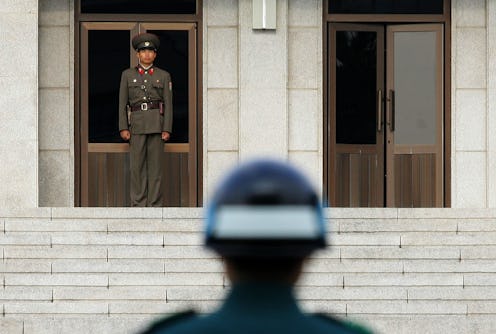News
Donald Trump's North Korea Strategy Is Getting Clearer

April 26 was an unusual day for the Senate — it was the first time the senators loaded up into buses en masse for the White House, to be briefed in an unconventional "all-hands" meeting on escalating tensions between the U.S. and North Korea. Many were unclear exactly what would come of the meeting, but the United States' North Korea strategy has seemed to become a little more cohesive following the nontraditional White House meeting.
The BBC reported that President Trump's North Korea strategy involves tightening sanctions in attempts to pressure Kim Jong-un to back off of his increasingly aggressive military posture. This confirmed reports from inside the meeting, which described putting "economic pressure" on North Korea in addition to upping military preparation.
A statement from Secretary of State Rex Tillerson, Secretary of Defense Jim Mattis, and Director of National Intelligence Dan Coats stated that the meeting was meant to brief Congress members on the review that Trump had ordered regarding on North Korea policy. "The president's approach aims to pressure North Korea into dismantling its nuclear, ballistic missile, and proliferation programs by tightening economic sanctions and pursuing diplomatic measures with our allies and regional partners," the statement read. The United States, they said, "seeks stability and the peaceful denuclearization of the Korean peninsula. We remain open to negotiations towards that goal. However, we remain prepared to defend ourselves and our allies."
Prior to the announcement of the official economic strategy, former National Security Council Director for China and Korea Laura Rosenberg explained the administration's unusual positioning on North Korea in an interview with Vox, and set the stage for the need for this new strategy:
What particularly worries me is the blustery rhetoric we are seeing from administration officials, which seem to be completely divorced from any practical steps or strategy.
The puzzling and startling North Korea rhetoric Rosenberg was referring to was that which lead up to Wednesday's meeting. That rhetoric included Vice President Mike Pence declaring that "all options are on the table" regarding military escalation between the combative Asian nation and the U.S., and ambassador Nikki Haley appearing to draw a red line in the country:
If you see him attack a military base, if you see some sort of intercontinental ballistic missile, obviously, we’re going to do that.
With the statement from Tillerson, Mattis, and Coats, it's clear that they're working toward finding a more concrete strategy. The officials said they're speaking with international community members to increase pressure on North Korea and that they plan to continue "close coordination and cooperation with our allies."
If nothing else, this newly announced strategy from the Senate illuminates the Trump administration's path forward in the tense situation with Pyongyang — a famously difficult relationship whose future appeared grim to many when Trump and his officials began escalating military dialogue.